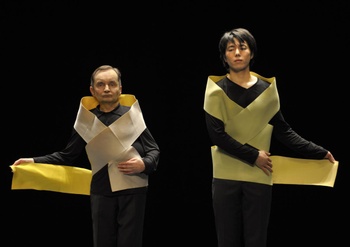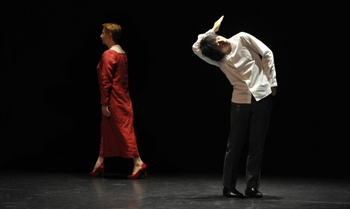(Raimund Hoghe & Takashi Ueno in Pas de Deux © Rosa Frank)
Late last year, the choreographer Raimund Hoghe presented a retrospective programme in his native Germany, entitled “20 Years – 20 Days”. The Kaaitheater, which has always stayed up to date with Hoghe’s work, is now staging two recent works by him.
From the “20 Years – 20 Days” programme, the Kaaitheater has taken a small exhibition of photographs by Rosa Frank of Hoghe’s past works. They are also presenting Pas de Deux, which, like many of Hoghe’s small choreographies, is one of a series of encounters with other artists, as well as a new group piece, Cantatas, in which – even more than in his other works – music plays a key role.
In Pas de Deux you share the stage with the young Japanese dancer Takashi Ueno.
Raimund Hoghe: I worked with him before in another piece [Si je meurs, laissez le balcon ouvert – MB] and I liked it a lot. He is a great dancer and a special person. There is a very strong link between us. He is like a brother or a son, so I wanted to do a piece with him again. Although some people think it is strange to see these two men do a pas de deux, there is nothing exotic about it. Since the beginning of my work I have always been very interested in Japanese culture, Japanese aesthetics, and Japanese theatre. When I was touring with Pina Bausch in the Eighties, I saw butoh for the first time in Avignon. In Pina’s work the struggle between man and woman was always very prominent. But butoh artists like Kazuo Ohno could be both man and woman, child or old person, and I like to cross those borders myself.
The formal aspect of Japanese theatre interests me too. The ritual aspect, the way they use time, etc. In butoh, which developed after World War II and Hiroshima, beauty is another important aspect that inspires me. Of course Takashi is not a butoh dancer, but a contemporary dancer living in France. But I am always interested in the history of a person and of the place he is from. Before we worked on this piece there was the disaster in Fukushima, which came as a big shock to Takashi and other Japanese dancers. So in Pas de Deux we also remember this history of Japan and nuclear power. There is a Japanese text in the piece of which you only understand the words Hiroshima, Nagasaki, Chernobyl, and Fukushima.
You also use some traditional Japanese objects.
Hoghe: There is a Japanese umbrella, the belt of a kimono, and the geta, the traditional Japanese sandal. The sandals are interesting because they alter your movements. They are a bit like ballet shoes because you can do a pointe with them. All these objects create difference and distance as tokens of a different culture.
Raimund Hoghe: encounters with a choreographer


(Cantatas © Rosa Frank)
Music is at the heart of Cantatas.
Hoghe: There is also a lot of music in Pas de Deux – Western popular and classical music, and cantatas. But Cantatas is a group piece in which the classical soprano Kerstin Pohle will sing a capella: a cantata by Bach, but also a lot of other singing, because cantare is the Latin for “singing”. Music in my pieces is always about emotions and memories. During rehearsals we remember many things from our own past, from artists in theatre and music that influenced us. All these memories you can see or feel in the piece, but we don’t do namedropping. We pay homage to Kazuo Ohno, Mary Wigman, and Merce Cunningham, but you can enjoy the piece even if you have no connection with those artists.
Raimund Hoghe: Pas de Deux • 16/1, 20.30, €12/16, Cantatas • 18 & 19/1, 20.30, €12/16, Kaaitheater, square Sainctelettesquare 20, Brussel/Bruxelles, 02-201.59.59, tickets@kaaitheater.be, www.kaaitheater.be
Music is at the heart of Cantatas.
Hoghe: There is also a lot of music in Pas de Deux – Western popular and classical music, and cantatas. But Cantatas is a group piece in which the classical soprano Kerstin Pohle will sing a capella: a cantata by Bach, but also a lot of other singing, because cantare is the Latin for “singing”. Music in my pieces is always about emotions and memories. During rehearsals we remember many things from our own past, from artists in theatre and music that influenced us. All these memories you can see or feel in the piece, but we don’t do namedropping. We pay homage to Kazuo Ohno, Mary Wigman, and Merce Cunningham, but you can enjoy the piece even if you have no connection with those artists.
Raimund Hoghe: Pas de Deux • 16/1, 20.30, €12/16, Cantatas • 18 & 19/1, 20.30, €12/16, Kaaitheater, square Sainctelettesquare 20, Brussel/Bruxelles, 02-201.59.59, tickets@kaaitheater.be, www.kaaitheater.be
Read more about: Podium
Fijn dat je wil reageren. Wie reageert, gaat akkoord met onze huisregels. Hoe reageren via Disqus? Een woordje uitleg.